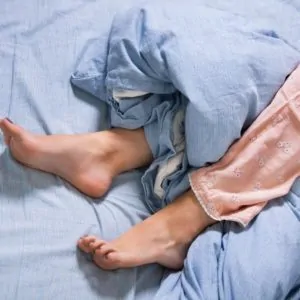
Symptoms
Symptoms generally occur for years before varicose veins, spider veins, or discoloration make the vein disease readily apparent. A definitive way to identify venous insufficiency – particularly in patients with normal appearing legs – is to perform a standing duplex venous ultrasound. Symptoms of venous insufficiency mimic those of Restless Leg Syndrome and, in patients without visible varicose veins and spider veins, there may be no clue that the underlying problem is a vein issue, not simply Restless Leg Syndrome. Because people with venous insufficiency do not drain fluid from their leg properly over the course of the day, fluid builds up in the calf and lower legs. Stretch receptors, nerve endings embedded in the muscles, get a message to activate because of the fluid engorging the lower leg and respond by creating a sensation to move the legs or, if overstimulated, cramp the muscle. This is an attempt to empty the fluid that has filled the muscle over the course of the day using the calf muscle pump, the mechanism for driving fluid in the legs back to the hear. In one study of patients with Restless Leg Syndrome, venous insufficiency was identified in 40%. Treating the venous insufficiency with a short, in-office procedure, eliminated the symptoms in 90% of the patients in the study. One could draw the conclusion that these patients actually had primary venous insufficiency, not Restless Leg Syndrome at all! Patients with Restless Leg Syndrome who may have underlying venous insufficiency can be identified using a simple ultrasound in the office, which is typically covered by insurance and Medicare. Laser vein treatment is typically covered by insurance, requires no downtime, and may be curative.Solutions
Dr. Malvehy is rated one of the best vein doctors in the East Bay and greater San Francisco Bay Areas. Patients can drive themselves home afterwards and there is no downtime. If you’d like to read more about the study examining laser vein treatment for treatment of symptoms of Restless Leg Syndrome, click here.“Dr. Malvehy & his staff are consummate professionals, I am thrilled with my results.”
Lillie R.

